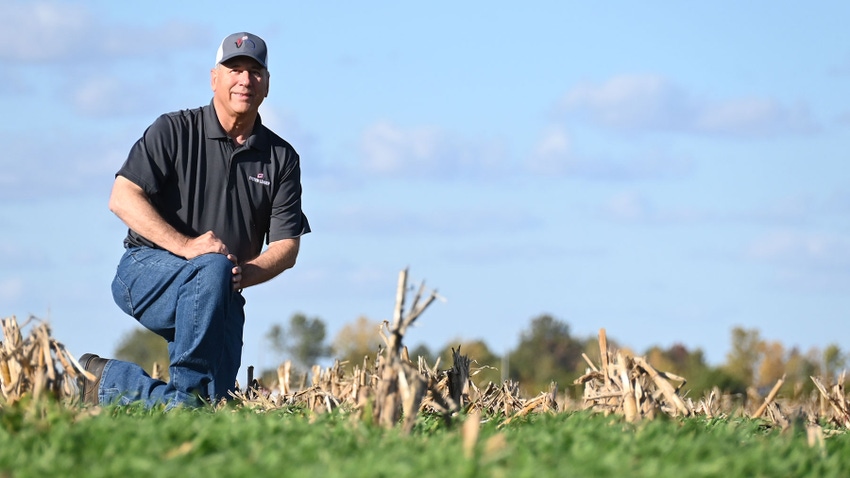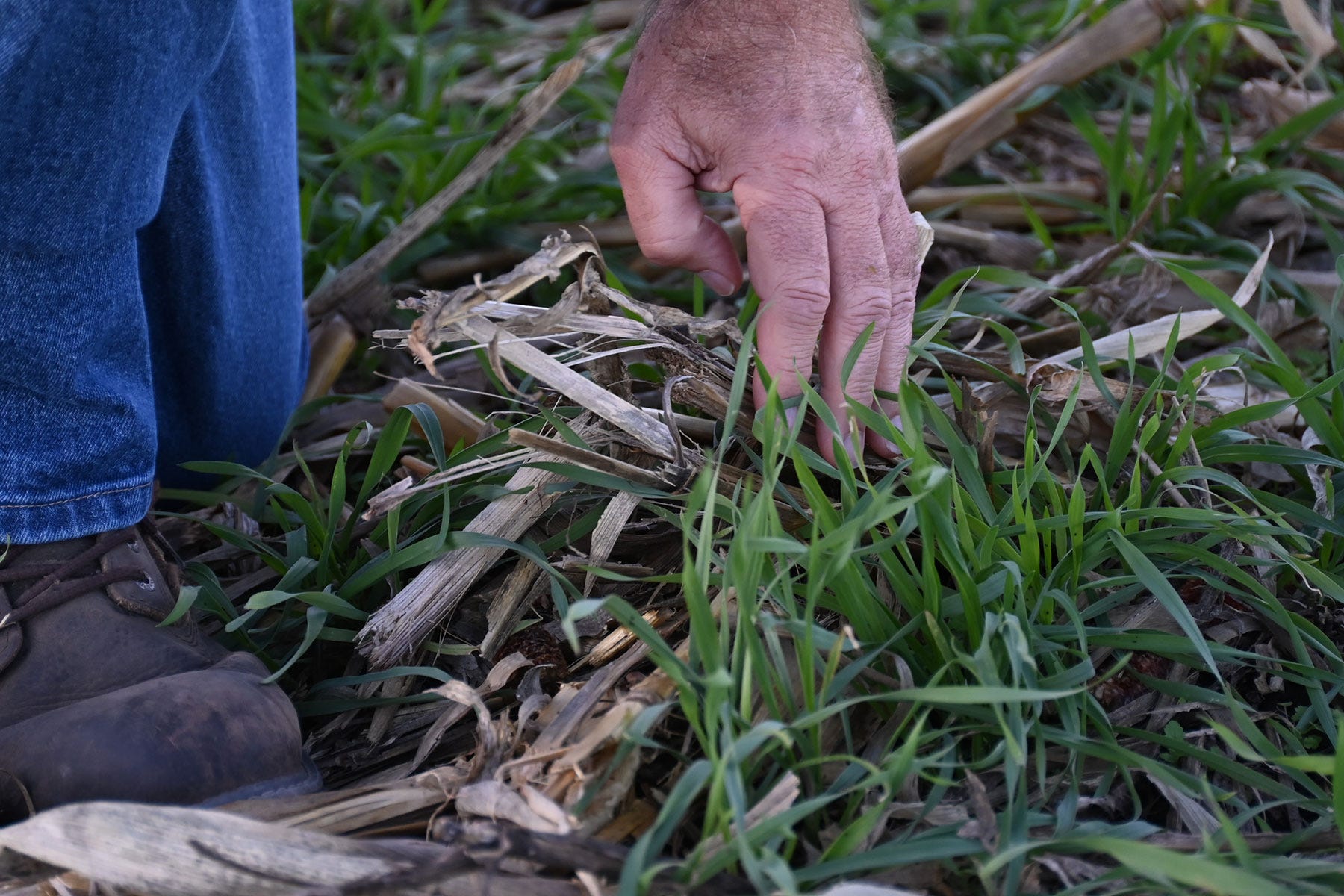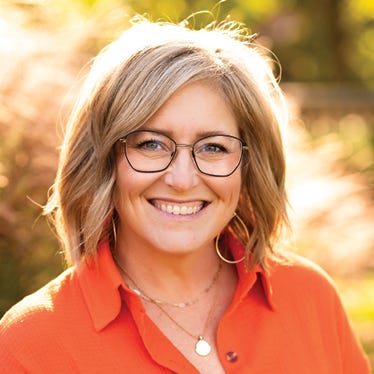
At a Glance
- With cover crops, Champaign County, Ill., farm shows no soybean yield drag over three years.
- Farmer spends $37.50 an acre to seed cereal rye but saves $50 an acre by eliminating tillage passes.
- His motivations include improving soil health, reducing nitrogen loss and holding soil in place.
Chris Hausman will be the first to tell you that he wasn’t looking for change. Hausman, 65, farms in southwest Champaign County, in the beautiful, flat black soil just south of Pesotum, Ill. He’s farmed a conventional tillage system all his life.
Then three years ago, he’d been thinking about ways to reduce nitrogen loss when the farm manager on one of his rental farms pushed him to try cover crops. So he did. Hausman planted 100 acres of cornstalks with cereal rye, with the help of cost-share dollars from the Natural Resources Conservation Service.
The next spring, he planted soybeans into it. No tillage. Come fall, he harvested a bean crop and a surprise: no yield drag.
So the next year, Hausman planted 100% of his 750 cornstalk acres to cereal rye, paying Illini FS to custom-seed. No tillage. He planted soybeans into standing rye, and in the fall of 2022, he harvested a crop that — again — yielded just as well as when he used to work the ground.
For the 2023 crop, he did it all again, hiring Illini FS to custom-seed 750 acres of cornstalks. And again this fall, he harvested beans with zero yield drag compared to his conventional tillage years. Three years in a row.
And now he’s all in for cover crops.
“So, you can teach an old dog new tricks!” Hausman says, laughing.
Dollars and sense
In terms of costs, Hausman says he’s dollars ahead by using cover crops. His yields have stayed the same. He pays Illini FS $37.50 an acre to custom-seed a straight cereal rye cover crop every fall, which includes 40 pounds per acre of cereal rye seed. They typically seed the rye immediately behind the combine, using a 40-foot no-till drill.
But he’s eliminated two and sometimes three tillage passes, including a fall chisel plow pass and one or two field cultivator passes. According to University of Illinois Farmdoc, it costs $36 an acre to run the chisel plow, and $14 an acre to run the field cultivator.
“Chisel plows drink fuel,” Hausman says, laughing. Then he does the math.
By eliminating just two tillage passes, he’s saving $50 an acre on tillage, compared to the $37.50 an acre he spends on cover crops. Figure two field cultivator passes, and he’s saving $64 an acre.

GREEN ACRES: Cereal rye already had a lush cover going on this southern Champaign County, Ill., farm in mid-October.
Hausman is also taking advantage of cost-share programs, including those through NRCS and the Illinois Department of Agriculture, that offer crop insurance discounts on cover crop acres. Champaign County officials used some of their federal ARPA (American Rescue Plan Act) money authorized following the pandemic to incentivize cover crops and improve water quality, and Hausman has tapped into those programs as well.
What he’s learned
Hausman’s cover crops learning curve went straight up, especially at spring planting time.
“As a 100% conventional till farmer, planting into a cover crop really pushed my comfort level,” he says, describing planting into foot-tall rye. “Without GPS, you would not have known where the rows were.”
And occasionally, those beans took three weeks to emerge and Hausman was sweating, wondering if he’d messed up. But he hadn’t, even if some of his neighbors thought he might’ve lost it.
“Soil is cooler because of the cover crops, and it’s not going to warm like conventional till, but the beans were healthy when they finally emerged, and they were fine,” he explains.
Here’s a look at what else Hausman has learned:
Terminate sooner. This year, Hausman terminated the cover crop about one week before planting, waiting as long as he could to make the residual last longer. “But it took forever to die,” he says. He’ll push that window earlier next year.
Don’t mix residual and burndown. Hausman has learned there’s an antagonistic effect between residual herbicides and glyphosate, which can keep the glyphosate from working as well or as quickly. So he’ll make two passes next year, applying the burndown earlier and then coming back with a residual.
Boost soybean populations. In his conventional tillage days, Hausman planted 15-inch soybeans with a Kinze planter at about 120,000 seeds per acre. That’s getting light in no-till cover crop environments, so he plans to push population to 135,000 to 140,000 next spring.
Fight early waterhemp. As a bonus, Hausman learned that a good cover crop can suppress waterhemp early on.
Real motivation
Honestly, Hausman says, there were several events that helped him keep an open mind and pull the cover crop trigger, beyond his farm manager’s encouragement. The STAR conservation program, which stands for Saving Tomorrow’s Agriculture Resources, is active in his area, where several neighbors have tried cover crops.
He’s also followed data from IL Corn’s Precision Conservation Management program, learning that other farmers were seeing consistent yields with cover crops, compared to conventional yields.
“That was my goal,” Hausman says. He wanted to know whether yield might be sacrificed due to no-till or due to no-tilling with a cover crop. As it turns out, neither was true — because he didn’t sacrifice any yield.
A recent Farmdoc article from Gary Schnitkey confirms Hausman’s observations: Cover crops only marginally reduce average soybean yields and have little to no effect on yield risk, and cover crops definitely reduce corn yields and yield risks.
“Corn is just really particular,” Hausman says, adding that he has no plans to plant corn into cover crops.
But he really likes that cover crops can improve his soil structure. Hausman visited Germany several years ago with an Illinois Farm Bureau delegation and observed how they’re constantly seeding and growing and harvesting crops there; the ground is rarely fallow. He wanted to hold nutrients in place.
“I didn’t like the idea of our pattern-tile drainage sending nitrogen down the Mississippi,” Hausman says. “It seemed like cover crops — following corn and whatever nitrogen’s leftover after you’ve raised the corn crop — wouldn’t it be great to put something out there that could capture and hold some of those nutrients in place?
“Then terminate ’em the following year and utilize ’em again.”
As it turns out, cover crops gave Hausman just the change he was looking for.
About the Author(s)
You May Also Like






